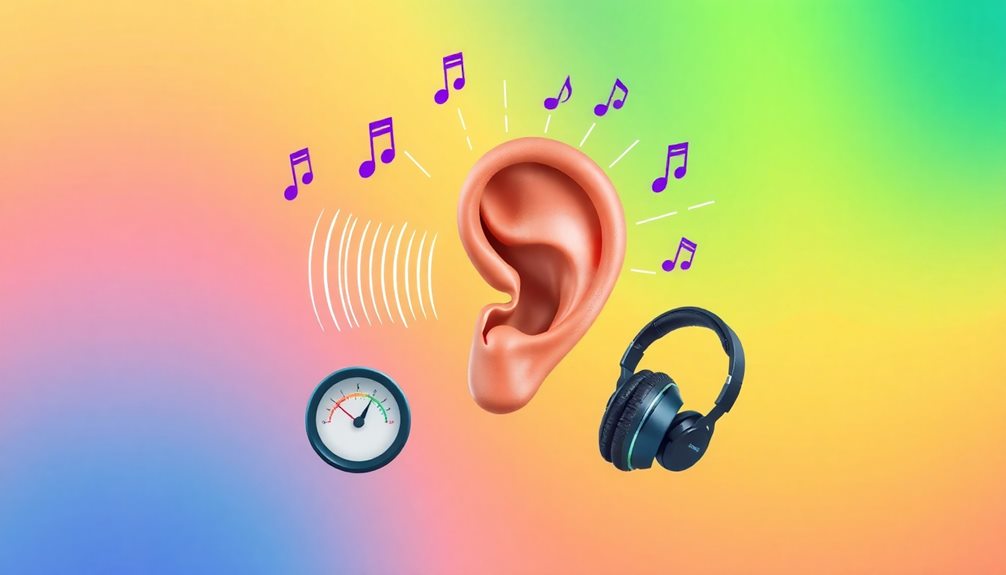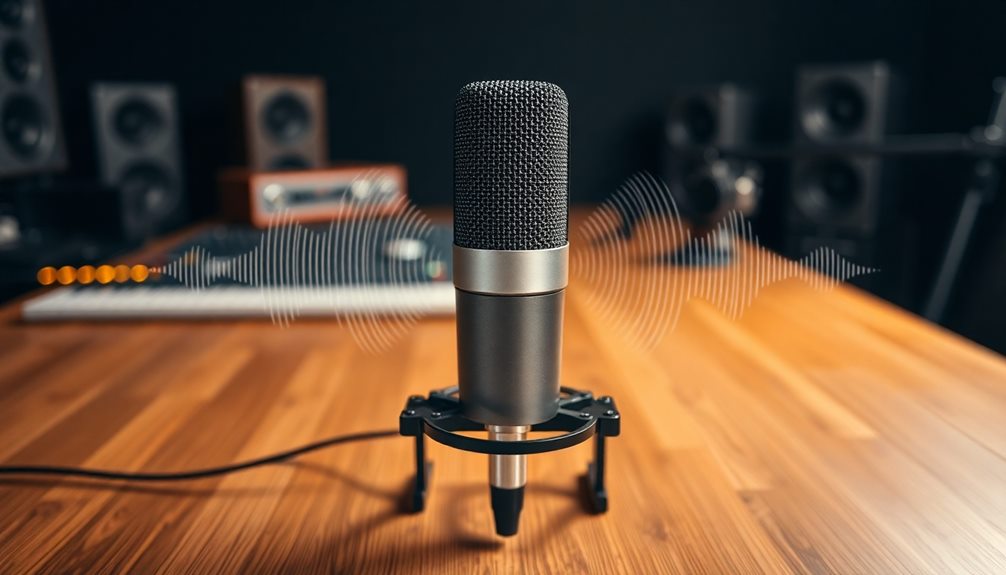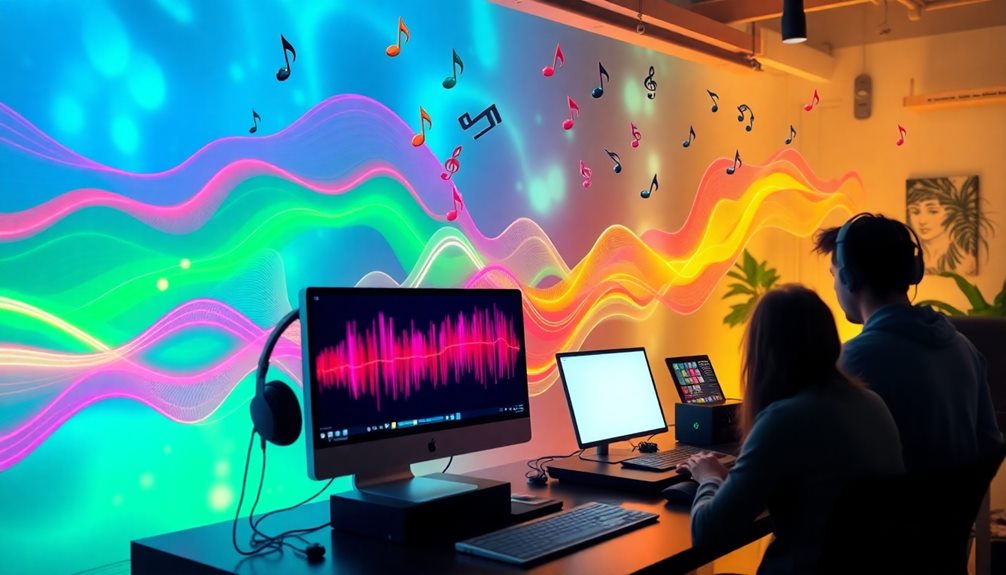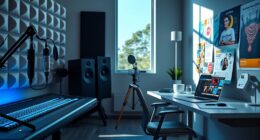Understanding decibel units is super important for you as a musician! Decibels (dB) measure sound intensity. For example, normal conversation is around 60 dB, while sounds above 85 dB can hurt your ears. A rise of 10 dB means the sound is ten times louder! You should keep your sound levels between -14 dB and -12 dB for great mixes, and during live shows, aim for 85 to 105 dB. Don't forget to protect your hearing, too! Using earplugs and taking breaks will help you stay safe while enjoying your music. There's so much more to discover!
Key Takeaways
- Decibels (dB) measure sound intensity, with 0 dB being the threshold of hearing and 120 dB causing potential ear damage.
- Understanding dBu and dBV voltage measurements ensures audio clarity and equipment compatibility in professional and consumer settings.
- Safe listening practices recommend keeping sound levels below 85 dB to prevent hearing loss, with regular breaks during exposure to loud sounds.
- Ideal production levels range between -14 dB and -12 dB RMS for tracks, while live performances typically vary from 85 dB to 105 dB.
- Acoustic treatment improves sound quality by reducing reflections and echoes, essential for clear audio production and mixing decisions.
Understanding Decibel Basics
When you immerse yourself in the world of sound measurements, understanding decibels (dB) is essential for any musician. A decibel measures how intense a sound is. It's like a special language that helps you describe sound.
For instance, the quietest sound you can hear is 0 dB, which is the threshold of human hearing. This level is super important!
Now, think about normal conversation. It usually measures around 60 dB. That's a comfortable level! But watch out! Sounds that hit 120 dB or higher can hurt your ears. Yikes!
To grasp how decibels work, remember that every increase of 10 dB means a tenfold rise in intensity. So if you go from 60 dB to 70 dB, the sound is ten times more powerful! Cool, right?
You can calculate the sound pressure level (dB SPL) using a formula: 20 × log (pascals / 0.00002). This formula shows how sound intensity grows.
Understanding decibels lets you play your music safely and enjoyably. So, immerse yourself and explore the exciting world of sound!
The Logarithmic Scale Explained

How does the logarithmic scale impact your understanding of sound? The decibel scale is based on a logarithmic scale, which means that every increase of 10 dB represents a tenfold increase in sound intensity. For instance, a 20 dB sound is ten times more intense than a 10 dB sound!
This way of measuring helps you grasp just how powerful sounds can be, from whispering at 30 dB to roaring concerts that can hit over 120 dB.
When you hear a change of +3 dB, it means the power output has doubled! Meanwhile, a +10 dB increase usually feels like a sound that's twice as loud to your ears.
This logarithmic nature of decibels makes it easier to work with the huge range of sound levels. Your ears can hear sounds from 0 dB, the quietest sound you can notice, all the way to over 180 dB, which is extremely loud!
Understanding the logarithmic scale is super important for you as a musician or sound engineer. It helps you mix and master your music and design audio equipment, ensuring your sound is always exceptional!
Sound Pressure Levels (SPL)

Understanding sound pressure levels (SPL) is essential for anyone working with audio, as it quantifies how intense a sound is in relation to human hearing. SPL is measured in decibels (dB SPL), and it starts at 0 dB SPL, which is the faintest sound we can hear, equal to a pressure of 0.00002 Pascals.
When you increase the SPL by 10 dB, you're making the sound ten times more intense! For example, a sound at 120 dB SPL is a whopping one million times louder than one at 0 dB SPL!
As a musician, knowing common SPL levels helps you protect your hearing. A normal conversation is around 60 dB SPL, while heavy traffic can be about 85 dB SPL. Rock concerts often go over 120 dB SPL!
It's important to remember that being around sounds above 85 dB SPL for a long time can hurt your ears.
To calculate SPL, you can use the formula: 20 × log (pascals / 0.00002). This helps you understand the connection between sound pressure and what you hear.
Voltage Measurements in Dbu and Dbv

Let's explore how voltage measurements, like dBu and dBV, play a big role in the world of music.
Understanding these units helps you connect your gear properly, ensuring the best sound quality possible.
Knowing the differences can really boost your audio performance, making your music shine!
Understanding Dbu Reference Levels
Recognizing the differences between dBu and dBV is vital for any musician or audio engineer working with various equipment.
Tips for effective location scouting can also enhance your sound recording experience when considering the environments in which you'll work. dBu measures voltage levels with a reference point of 0.775 volts, while dBV uses 1 volt as its standard reference. This might seem tricky, but it's really significant!
In the world of audio, a +4 dBu signal is often the gold standard. It equates to about 1.228 volts, which is perfect for professional audio gear. On the flip side, 0 dBV equals 1 volt, making it more common in consumer electronics.
This is where confusion can sneak in. You see, +4 dBu is actually the same as -10 dBV. That means it's a lower signal level, often found in home audio setups.
For sound engineers like you, understanding these reference levels is vital. It helps guarantee that all your devices and systems work well together.
Importance of Dbv Measurements
When working with audio equipment, knowing dBV measurements can greatly impact your performance and sound quality. dBV is a way to measure voltage, and it's referenced to 1 volt. When you see 0 dBV, it means the signal is at 1 volt, which is common in consumer electronics.
For audio engineers like you, understanding these voltage measurements is super important! Why? Because it helps guarantee that your equipment works well together. You might come across dBu too, which measures voltage based on 0.775 volts. Confusion can easily happen when dealing with these different systems.
But if you get familiar with dBV and dBu, you'll have the tools to manage your sound effectively. Accurate voltage measurements in dBV help prevent distortion, keeping your audio clear and true.
Whether you're recording in the studio or performing live, this knowledge lets you maintain audio integrity. So, plunge into those dBV measurements! They're not just numbers; they're keys to revealing the best sound possible. Embrace them, and watch your music come to life!
Voltage and Audio Quality
Understanding voltage measurements in dBu and dBV is essential for achieving ideal audio quality. dBu, with its reference level of 0.775 volts, is commonly used in professional audio environments, where +4 dBu represents a standard line level of 1.228 volts.
On the other hand, dBV simplifies things with a reference of 1 volt, so 0 dBV equals 1.0 volts, while -10 dBV represents a nominal output level of 0.317 volts.
Knowing the difference between dBu and dBV is important for you as an audio professional. Confusion can happen due to the various reference points used in these voltage measurements.
Accurate voltage measurements are essential for maintaining sound quality and ensuring compatibility across different audio equipment.
You can measure sound level using a handy formula: \( dB = 20 imes \log(ext{voltage}/1) \). This helps you calculate voltage levels in decibels (dB), making your work easier.
Digital Measurements and Headroom

In the world of digital audio, maintaining proper levels is essential for achieving high-quality sound. You'll often hear about dB FS, which stands for decibels relative to full scale. This measurement helps you understand how close your audio is to the maximum level. At 0 dB FS, you're at the peak, but going beyond that can lead to nasty clipping and distortion. That's why headroom is super important!
During mixing, you want to keep your levels below 0 dB FS, typically between -14 dB and -12 dB RMS for a clean sound. This way, you have room to breathe without losing quality.
Also, the bit depth of your digital audio system impacts the dynamic range. A 24-bit system can give you a whopping 144 dB of dynamic range, allowing you to capture every little nuance in your music.
Many studios calibrate their equipment to around -20 dB FS or -18 dB FS. This helps keep everything consistent between the analog and digital worlds.
Safe Listening Practices

When you listen to music, it's super important to keep your volume at a safe level!
You'll want to aim for a maximum of 85 dB to protect your hearing, and using tools like decibel meters can help you keep track.
Plus, don't forget to take breaks and consider wearing ear protection in loud places—your ears will thank you!
Maximum Volume Guidelines
Protecting your hearing is vital for any musician, as prolonged exposure to high volumes can lead to irreversible damage. Did you know that sounds above 85 dB can cause stress to your hearing? That's why it's important to monitor your dB levels during practice and performances.
For instance, if you're in a loud concert, the maximum exposure time to 115 dB is only 28 seconds! Without ear protection, you could risk serious hearing issues.
Using personal music players can also be risky. They can exceed 100 dB, which is pretty dangerous if you're listening for a long time. Be certain to take breaks during long listening sessions. This gives your ears a chance to recover from those loud sounds and helps protect your hearing.
To keep track of your sound levels, consider using a decibel meter or an app. These tools can help you verify you're staying within safe limits while rocking out.
Monitoring Sound Levels
Monitoring sound levels is vital for maintaining your hearing health as a musician. You need to know that prolonged exposure to sound levels above 85 dB can cause hearing damage. That's why it's super important to keep track of your environment and the sound levels around you.
Personal music players can blast over 100 dB, so aim to keep the volume below this threshold to protect your ears.
Using decibel meters or handy mobile apps can help you regularly check sound levels during rehearsals and performances. This way, you can guarantee you're staying within safe limits.
Remember, taking breaks during long listening sessions is essential! It allows your ears to recover, helping to reduce the risk of hearing fatigue and long-term damage.
As you embrace your musical journey, keep safety in mind. By monitoring sound levels and being aware of your surroundings, you can enjoy your passion without compromising your hearing.
Hearing Protection Options
Hearing protection is essential for musicians, as even a few minutes of exposure to high sound levels can lead to lasting damage. When you're surrounded by the loud sounds of live music, it's vital to think about your hearing safety. Sound levels above 85 dB can harm your ears, so wearing the right gear is important!
Custom-moulded earplugs are a fantastic option for live performances. They fit your ears perfectly and reduce sound levels without making the music sound muffled. This way, you can enjoy the show while keeping your hearing safe.
Plus, using decibel meter apps helps you track the sound levels around you. It lets you know when it's time to take a break or turn down the volume.
Also, don't forget to rest your ears! Taking short breaks during long listening sessions can really help.
And remember, regular check-ups with an audiologist are a smart idea, especially for musicians. They can catch any early signs of trouble and keep your hearing in great shape.
Ideal Db Levels for Production

What're the ideal dB levels for music production? When you engage in creating music, it's important to know the best volume levels to use. The recommended average volume for your tracks should be between -14 dB and -12 dB RMS. This range helps guarantee your sound is clear and free from distortion while mixing and mastering.
Understanding how decibels work as a unit of measurement is key, too. For live performances, sound levels often hit between 85 dB and 105 dB. That's pretty loud! So, don't forget your ear protection to keep your hearing safe.
You'll also want to maintain consistent audio levels. This keeps your listeners engaged and prevents them from feeling fatigued, whether they're enjoying a live show or a recorded track.
Plus, monitoring your dB levels while performing is essential for delivering the best sound experience possible.
The 3 Decibel Rule

Understanding the 3 Decibel Rule is essential for anyone involved in music production or live sound. This rule tells you that when you increase sound by 3 dB, you're actually doubling the power of that sound. That's pretty important to know!
For example, if you raise the volume from 60 dB to 63 dB, the power doubles, which can change how your mix sounds.
On the flip side, if you lower the sound by 3 dB, you're halving the power. This shows just how vital it's to make precise volume adjustments. You want to keep your sound balanced, right?
The 3 Decibel Rule isn't just about power; it also applies to voltage and sound pressure levels. If you increase those by 6 dB, you double them too!
Importance of Acoustic Treatment

Enhancing your sound environment through acoustic treatment is essential for achieving professional audio quality in both recording and performance spaces. When you improve sound clarity, you create a better experience for everyone involved.
Acoustic treatment reduces reflections and echoes, which can muddy your sound. By using materials like foam panels, bass traps, and diffusers, you can manage sound waves effectively.
Imagine mixing your music and hearing every detail clearly. With proper acoustic treatment, you'll notice less unwanted noise and frequency buildup. This clarity allows you to make better production decisions.
Plus, it helps keep the volume levels at a comfortable range, measured in decibels (dB), ensuring your music sounds great without straining anyone's ears.
Combining soundproofing with acoustic treatment is also important. While soundproofing blocks outside noise, acoustic treatment focuses on the internal sound quality.
If you're unsure where to start, consulting with acoustic professionals can lead to tailored solutions for your specific space. They can help you create an environment that enhances your music and brings joy to your audience.
Frequently Asked Questions
What Db Level Should Music Be?
For music production, aim for -14 dB to -12 dB RMS to guarantee clarity. In live settings, keep levels between 85 dB and 105 dB, and always use ear protection to safeguard your hearing.
How Do You Understand Decibels in Music?
To understand decibels in music, you need to grasp how sound intensity works. Pay attention to volume levels, as they can impact clarity and potentially harm hearing. Always monitor levels during rehearsals and performances for balance.
What Db Is Too Loud for Music?
Sounds over 85 dB can damage your hearing, while anything above 115 dB is only safe for about 28 seconds. If you hit 120 dB, it's painful and potentially harmful. Keep your volume in check.
How Loud Is 70 Decibels Music?
When you listen to music at 70 decibels, it feels similar to a vacuum cleaner running. It's a comfortable volume, safe for your hearing, but take breaks to avoid slight fatigue during long sessions.
Conclusion
Now that you know the basics of decibels, you're ready to rock! Did you know that every time you double the sound level, it increases by about 3 decibels? That means even small changes can make a big difference! Remember, keeping your sound levels safe is super important for your ears and your music. So, whether you're mixing tracks or jamming with friends, always keep an eye on those decibels. Let the music play, but play it safe!










